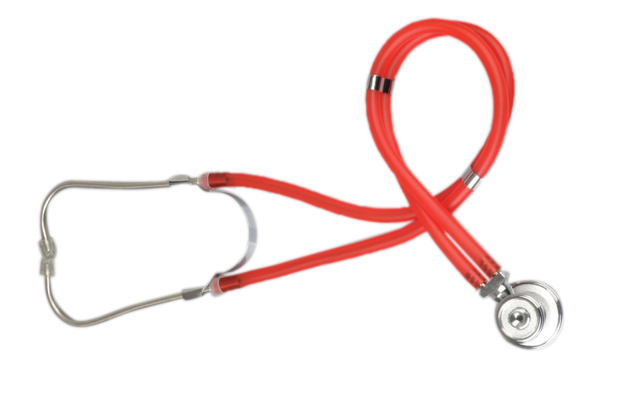
Sprague-Rappaport Stethoscope
The Sprague-Rappaport Stethoscope is an old-fashioned stethoscope that has been around since the late 1800s. In those days, many doctors had their own and they were perfect for taking blood pressure readings or listening to heart and lung sounds. The medical world has evolved a lot in the last 150 years though, and while this kind of stethoscope is still used by surgeons today, it's not as common as it once was.
Sliver Head, half-transparent tubing.
Sprague-Rappaport stethoscopes are one of the most popular types of stethoscopes on the market today. They are known for their durability and versatility, and are a favorite among medical professionals. A Sprague-Rappaport stethoscope is a type of acoustic stethoscope. It consists of two chest pieces, one bell-shaped and one diaphragm-shaped, that are connected by tubing. The bell is used to listen to low frequency sounds, while the diaphragm is used to listen to high frequency sounds. The advantage of a Sprague-Rappaport stethoscope over other types of stethoscopes is that it can be used in both adults and children. It is also less likely to cause discomfort when used on patients with sensitive skin.
The Sprague-Rappaport stethoscope is a versatile and affordable device that offers many features for both medical professionals and patients. The most notable feature of the Sprague-Rappaport stethoscope is its two-sided chest piece, which allows for both high and low frequency sound transmission. Additionally, the stethoscope comes with three different sized ear tips to ensure a comfortable fit for all users. The Sprague-Rappaport stethoscope also features a non-chill rim and diaphragm to help prevent discomfort during use.
Assuming you have your Sprague-Rappaport stethoscope and it is the correct size for you, here are instructions on how to use it. First, find a comfortable position for both you and your patient. The stethoscope should be positioned perpendicular to the chest piece so that you can hear sounds clearly. Next, place the diaphragm of the stethoscope on the patient's skin and apply slight pressure. You may need to experiment with different amounts of pressure in order to hear properly. Finally, listen carefully and try to identify any abnormal sounds.
There are several key differences between a Sprague-Rappaport stethoscope and a Littmann stethoscope. First, the Sprague-Rappaport is a two-sided stethoscope, meaning that it can be used for both adult and pediatric patients. Second, the Sprague-Rappaport has a double lumen tubing design, which allows for improved sound quality. Third, the Sprague-Rappaport has a non-chill ring on the diaphragm, which helps to improve patient comfort. Finally, the Sprague-Rappaport is less expensive than the Littmann stethoscope.
When choosing the size of open bell, diaphragm, and ear tips for a person, it is important to consider the individual's body size and shape. The best size for each person may vary depending on these factors. For open bell sizes, a good rule of thumb is to choose a size that is approximately half the diameter of the person's chest. This will ensure that the bell can fit snugly against the chest without being too loose or too tight. For diaphragm sizes, it is important to choose a size that covers the entire opening of the ear canal. This will ensure that sound can be transmitted effectively through the diaphragm and into the ear. Ear tips should be chosen based on the size of the person's ear canal. In general, smaller ear canals will require smaller ear tips, while larger ear canals will require larger ear tips. It is also important to make sure that the ear tips fit snugly but comfortably into the ears, as this will help to improve sound quality.